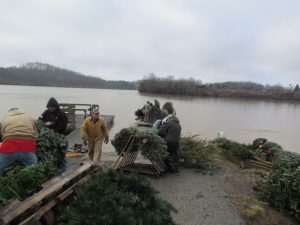 Those who enjoy a natural pine, cedar, spruce or fir tree for Christmas often don’t know what to do with it after the holidays. Many resort to putting it out on the street or chucking it in the backyard until spring.
Those who enjoy a natural pine, cedar, spruce or fir tree for Christmas often don’t know what to do with it after the holidays. Many resort to putting it out on the street or chucking it in the backyard until spring.
You can dispose of your natural Christmas tree and provide habitat for fish by donating it to the Kentucky Department of Fish and Wildlife Resources instead of the tree languishing in the corner of your back yard or being ground into mulch.
“Every year we try to get a large number of Christmas trees, so we can sink them as fish habitat,” said Ron Brooks, director of fisheries for Kentucky Fish and Wildlife. “We place them on wooden pallet habitat structures to diversify the habitat or sink just the trees themselves.”
Kentucky Fish and Wildlife will accept trees at 35 locations in 29 counties across Kentucky until Jan. 15. Trees must be natural and free of lights, ornaments, tinsel, garland or any other decorations.
“We added sites this year in our two most populous counties, Jefferson and Fayette,” said Joseph Zimmerman, fisheries habitat program coordinator for Kentucky Fish and Wildlife. “We added a site at McNeely Lake in Jefferson County and at Jacobson Park in Lexington. We’ve added 15 additional collection sites across the state since 2012.”
To find a convenient location near you, visit the Kentucky Fish and Wildlife website at www.fw.ky.gov and type in the keyword “Christmas” in the search engine on the top right corner of the page
The construction of most of our state-owned lakes and large reservoirs date to the period from the end of World War II to the early 1970s. As these waterbodies age, the woody cover in them melts away, leaving them starved for habitat.
“Just about all of our reservoirs and state-owned lakes have a habitat problem,” Brooks said. “The aging lakes have a bare substrate; there is not a lot of woody habitat or aquatic vegetation left, especially in reservoirs with highly fluctuating water levels.”
The Christmas Trees for the Fishes program is part of an overall effort to remedy this problem by replacing the lost habitat with items such as Christmas trees, wooden pallet stacks, buckets filled with wooden stakes and other items.
“This is an effort that every fisheries district does,” Brooks explained. “It’s helped out on lakes as large as Kentucky Lake and Lake Barkley and on our smallest state owned lakes. The Christmas trees help make our pallet stacks more complex which provides better cover for fish.”
Brooks said algae grows on the sunken Christmas trees, creating multiple benefits for fish.
“Invertebrates lay eggs on the algae and they become a food source for smaller fish, which in turn attracts larger fish,” Brooks said. “It has a two-pronged benefit by providing habitat and a food source.”
The habitat placed in the lakes by fisheries personnel is recorded for use by anglers by plotting the Global Positioning System (GPS) coordinates on maps on the Kentucky Fish and Wildlife website at www.fw.ky.gov. Type in “Lakes with Fish Attractors” in the search engine on the homepage to use this valuable information.
Don’t chuck your Christmas tree beside the shed in the backyard until March. Drop it off at one of the collection stations and make better fishing for all Kentuckians to enjoy in the years to come.
 Weather
Weather Traffic
Traffic @LouisvilleDispatch
@LouisvilleDispatch @LouisvilleDisp
@LouisvilleDisp Subscribe
Subscribe